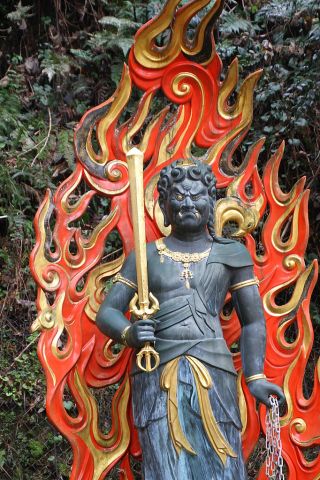Suicide
A Postscript and Postmortem on the Suicide of Aaron Bushnell
A comment on the ideological polarization surrounding Bushnell's death.
Updated March 3, 2024 Reviewed by Monica Vilhauer
Key points
- Our ideological beliefs influence how we view self-immolation as a political act.
- Regardless of cultural sanctioning, the term "suicide" doesn't depend on its motive.
- We risk cultural appropriation when we impose a framework on a person's suicide that was not their own.

In my last post, I wrote about the practice of self-immolation from a historical and psychological perspective in an effort to help us understand the recent death of US airman Aaron Bushnell, who set himself on fire on February 25, 2024 to protest the Israel-Gaza War. My general conclusion about self-immolation—if not about Bushnell, given the lack of information about him and the obvious fact that I have not examined him as a psychiatrist—is that it is often an act of both protest and suicide, with the latter requiring a closer look at why someone would be willing to end their life for a cause.
Other opinions since his death have been predictably split in a more black-and-white fashion between those calling him a hero for his powerful statement of protest and those claiming that his suicide was evidence of mental illness.
As it happens, I recently wrote about how a similar “blame” or “explain” framework is often used to opine about mass shooters and terrorists, depending on whether the perpetrator’s ideology matches our own. While I’m not equating self-immolation with terrorism, they both can be understood as political acts and it’s fair—and even obvious—to say that something similar has been going on with how people view Bushnell’s death. Those who feel similarly empathic about the plight of Palestinians are likely to view him as a hero and a martyr who completed the ultimate act of protest. Conversely, those adopting a more sympathetic view of Israelis as victims of a terrorist attack perpetrated by Hamas that set the war in motion are likely to call Bushnell’s death a suicide, whether driven by mental illness, radical anarchist ideology, or both.
Suicide Is Suicide
Ideologically-driven black-and-white thinking doesn’t get us very far, however, whether we’re talking about terrorism, mass shootings, or self-immolation.
For example, after I tweeted about my blog post on X, someone responded with another tweet that claimed:
Aaron Bushnell did not commit suicide. Suicide is something one does when they don’t want to be alive anymore. Bushnell would’ve been happy to on living, but he saw Gaza as more important than his own life. His death was exactly what he said it was: an extreme act of protest.1
This kind of either/or thinking is overly simplistic. Suicide is suicide. The motive behind taking one’s life has no bearing on whether it warrants that label. As I tweeted in response, Bushnell’s death could not have been an “extreme act of protest” if it wasn’t also a suicide.
Another person tweeted a link to a letter by the Buddhist monk Thích Nhất Hạnh in 1965 written to Martin Luther King Jr., commenting on the self-immolation of Thích Quảng Đức and the many other monks and nuns that followed in his path in protest of the treatment of Buddhists under the Diem Regime in Vietnam at the time. In the letter, he argued that such self-immolation was neither “protest” nor “suicide,” noting that:
To burn oneself by fire is to prove that what one is saying is of the utmost importance. There is nothing more painful than burning oneself. To say something while experiencing this kind of pain is to say it with the utmost courage, frankness, determination, and sincerity… To express will by burning oneself, therefore, is not to commit an act of destruction but to perform an act of construction, i.e. to suffer and to die for the sake of one’s people. This is not suicide. Suicide is an act of self-destruction, having as causes the following: lack of courage to live and to cope with difficulties, defeat by life and loss of all hope, [and a] desire for non-existence. This self-destruction [of suicide] is considered by Buddhism as one of the most serious crimes. The monk who burns himself has lost neither courage nor hope; nor does he desire non-existence. On the contrary, he is very courageous and hopeful and aspires for something good in the future. He does not think that he is destroying himself; he believes in the good fruition of his act of self-sacrifice for the sake of others… he is practicing the doctrine of highest compassion by sacrificing himself in order to call the attention of, and to seek help from, the people of the world.2
Missing the Point
While Nhất Hạnh’s perspective helps to frame self-immolation within the lens of Buddhist philosophy, it’s important not to conflate Quảng Đức’s self-immolation with Bushnell’s. Bushnell was a self-described anarchist, not a Buddhist monk, and to apply a Buddhist framework to explain his death reeks of cultural appropriation. In my academic work on culturally sanctioned suicide,3 I’ve made the same point about seppuku, the ritual practice of suicide by stabbing oneself with a sword, in Medieval Japan:
A suicide that involves borrowing a ritual from another culture and time in an attempt to romanticize a desperate, isolated act does not make it [seppuku], any more than a casual benediction offered among friends while serving wine and crackers as refreshments should be equated with the rite of Catholic Eucharist.4
In a similar way, the cultural and psychological meaning of the Hindu practice of sati, the ritual self-immolation of a widow upon her husband’s funeral pyre, shouldn’t be imposed on the kind of self-immolation by women currently practiced in Muslin countries like Iran and Iraq, which is both a protest against oppression and an escape from suffering, any more than it should be to Bushnell’s female counterpart who set herself on fire in front of an Israeli consulate back in December.
Beyond cultural appropriation, the other peril of rationalizing Bushnell’s death by aligning it with Quảng Đức’s is that we risk misunderstanding the meaning of what his suicide actually meant to him. At the end of my previous post, I noted that we might never know the answer to that question, but the same person who tweeted Nhất Hạnh’s letter also linked a summary of Bushnell’s “anarchist convictions,” including support for “the abolition of all hierarchical power structures, especially capitalism and the state,” as seen through the eyes of his friends. Although a picture of what Bushnell meant to the friends he met through his political activism emerges from that summary, it falls short of explaining what Bushnell’s own life meant to himself. Why did he self-immolate instead of choosing other forms of politically activism? Why didn’t he chain himself to the gates of the Israeli embassy? Go on a hunger strike? Throw a can of tomato soup on the Mona Lisa?
When Is Suicide or Murder Socially Acceptable?
Returning to Nhất Hạnh’s words, it’s also not clear that Bushnell hadn’t lost hope or that he didn’t desire non-existence. Would he really have been “happy to go on living,” given his perceived state of the world? In any case, as I wrote before, suicide is suicide. Self-destruction is self-destruction. A life lost is a life lost.
And while Nhất Hạnh wrote about the fruition of self-sacrifice, just as those whose beliefs about the Israel-Gaza War have been quick to herald Bushnell’s suicide as a brave, courageous, and heroic act that will benefit the plight of Palestinians, it’s not at all clear that it will. For all we know, his death won't save any other lives. And worse, it could spark copy-cat suicides based on all manner of motives under the guise of noble political protest.
Despite the death of more than 100 Tibetan monks by self-immolation to protest China’s oppression of Tibet over the past decade, the Dalai Lama has remained neutral on the subject, preferring to neither encourage more suicides or to diminish their sacrifice.5 I think that’s a good blueprint for how we might view Bushnell’s death.
Just so, in an op-ed published four days after Bushnell’s death, political scientist and author Shadi Hamid mused about the highly polarized response to his suicide, calling Bushnell’s politics “extreme,” “silly,” “absurd,” and even “reprehensible,” while making note of his oversimplification of the Israel-Gaza war, viewed through the “simplified lens of colonized and colonizer.”6 Using that lack of nuance to turn away from the subject of Bushnell, Hamid instead concluded by shifting his attention to what Bushnell presumably wanted us to see: the suffering in Gaza.
Using words other than “suicide” to describe Bushnell’s death strikes me as reminiscent of how we restrict the meaning of the word “murder” to killing that we believe is unjustified so that we avoid it in the context of war. But when is suicide justified or acceptable? When is murder justified or acceptable? It’s the answer to those questions that lie at the heart of how differently we view both Bushnell’s death and what is happening in Gaza now.
Just so, however we try to unravel the complexity of Busnell's suicide, it was undeniably a political protest. As such, our view of it cannot be disentangled from our own views on what he was protesting.
If you or someone you love is contemplating suicide, seek help immediately. For help 24/7 dial 988 for the National Suicide Prevention Lifeline, or reach out to the Crisis Text Line by texting TALK to 741741. To find a therapist near you, visit the Psychology Today Therapy Directory.
References
1. Johnston C. https://x.com/caitoz/status/1763337307363701204?s=20; February 29, 2024.
2. Nhất Hạnh T. In search of the enemy of man; June 1, 1965.
3. Pierre JM. Culturally sanctioned suicide: Euthanasia, seppuku, and terrorist martyrdom. World Journal of Psychiatry 2015; 5:4-14.
4. Pierre JM. Suicide, swords, and cultural sanctioning. The American Journal of Forensic Medicine and Pathology 2014; 35:284.
5. Vehaba A. Buddhism, death, and resistance: What self-immolation in Tibet has borne. Politics, Religion, and Ideology 2019; 20:215-243.
6. Hamid S. How can one suicide protest be heroic and another crazy? The Washington Post; February 29, 2014.




